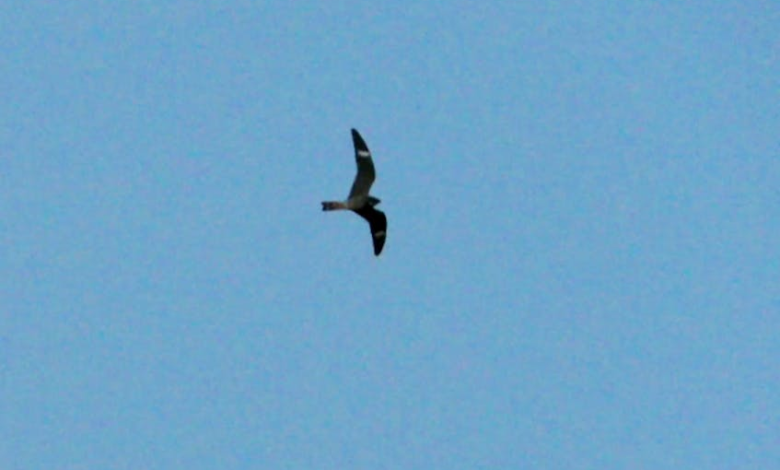Listening for the elusive nighthawk in the Purcells Cove Backlands

The search for the elusive nighthawk in the Purcells Cove Backlands has produced a rare recording of a mating pair with their offspring.
And the folks who aim to limit development of the 1,350-hectare wilderness area between Purcells Cove Road and Herring Cove Road hope to produce more research next spring and summer to prove it is home to more common nighthawks, a species at risk in Nova Scotia.
“We spot them. But they are … elusive. So, you see them way up high in the air catching insects and it’s at dusk or it’s at dawn,” Martha Leary, a director of the non-profit Williams Lake Conservation Company, said Wednesday.
“When they do come down to earth, they land usually in an area where they look exactly like the leaves that they land in. It’s like they disappear when they hit the ground.”
More proof
While birders can spot them flying at dusk and dawn, the Backlands Coalition — made up of groups that use the area for hiking, biking and enjoying nature — wanted more proof.
“We thought we should be a little more specific about the habitat that supports the nighthawk because as more development moves into the area it’s more likely that we’ll disturb them,” Leary said.
A nighthawk nest doesn’t look like much, though it would be easily disturbed by foot traffic, bicycles or dogs. “It’s just an egg sitting on a rock,” she said.
‘Hot spots’
This past August, Leary contacted Cindy Staicer, a retired Dalhousie University biologist, who agreed to loan an autonomous recording unit to a small group of volunteers who wanted to learn more about nighthawks in the backlands.
“We identified five sites in the backlands that we thought were possible areas where they might hang out, where they might nest, where they might call their territory,” Leary said.
They programmed the borrowed device to record for three hours at dawn and dusk.
“What we found was that there were certain areas that were real hot spots,” Leary said. “There were recordings that showed that there would be three nighthawk voices in an area — which means that’s a nest. It means that there’s a pair and that there’s an offspring. That’s really, really exciting.”
‘Very exciting’
Staicer analyzed their recordings. “She was really encouraged,” Leary said. “To find that there was evidence of breeding nighthawks within a 10-minute (drive) — or perhaps an hour-long walk — from downtown Halifax, was very exciting to her as well.”
The Williams Lake Conservation Company scraped together $800 to buy four of the recording devices. The plan is for two Dal students to help gather more evidence next spring and summer, listening for more common nighthawks.
“What we hope to find is that there’s more than one breeding pair,” Leary said.
They aim to prove that preservation of the wilderness in the backlands “is of utmost importance to this species whose numbers are declining rapidly,” she said.
‘Whittled away’
“We have seen two adults with two juveniles two years ago, in the air, but we aren’t ornithologists and we needed something that was scientifically more acceptable,” Leary said.
Development in the area is constant, she said. “The backlands are whittled away at the edges, especially along Herring Cove Road,” she said.
“It’s always, always under threat.”
For Fulton Lavender, a consultant on the project, the common nighthawk’s call sounds like they could be ordering drinks.
‘Saying beer’
“I liken it to a sound like they’re saying beer,” Lavender said.
“It has that buzzy E sound.”
The sound a common nighthawk makes to mark its territory “is called booming,” said Lavender, a professional birder who has been studying them in the backlands since 1984.
“They fly up to gain a little bit of height, and they accelerate their wing beat going up a little bit and then they dive,” he said.
“Then right at the end of the dive, they pull up really fast and the air goes through their feathers, and it makes varoom sound. … And wherever they boom, that is exactly where their nesting territory is.”
‘Apt to boom’
The common nighthawk, which flies south for the winter, is loudest at the peak of its breeding season, Lavender said. “They’re more aggressive, of course. They’re apt to boom any time they see a competitor.”
Common nighthawks can be spotted during the day, he said.
“They’re a capturer of insects on the wing,” Lavender said.
“Their prime food is various types of beetles. They’re very fond of June bugs.”
Recording devices are getting better “at getting crystal-clear sound so that you can pick out the nighthawk amongst all the others,” Lavender said.
“Nothing is safe to be preserved unless we go back and prove it’s still there every single year.”
‘Darting about’
Photographer Joshua Barss Donham has shot video of common nighthawks flying above the backlands.
“This was during the daytime, but around dusk,” Barss Donham said. “It was in the summer, when they were nesting.”
He’s taken still images from the video that look like adult nighthawks flying in the area where researchers later recorded their calls.
“It was partly on the basis of the nighthawk activity we were seeing in this area, on the jack pine-broom crowberry barrens east of the Governor’s Brook housing development, and also at the suggestion of Geoffrey Grantham (a local artist who paints en plain air in the Backlands and who noticed many nighthawks there), that we set up the (autonomous recording unit) there in August,” Barss Donham said in a followup email. “I did get many audio recordings and frequently saw nighthawks darting about feeding while the (autonomous recording unit) was there. This spot was the most fruitful of the five locations where the (autonomous recording unit) was placed.”




